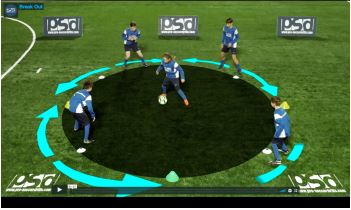Playing the 4v4 Soccer Game
A 4v4 soccer game is a well-known and very famous game to play. It is played on a smaller pitch than 11-a-side football so it is appropriate for the number of players on the pitch. This game is often called futsal but futsal itself is kind of a different game. It has other rules and conditions than a simple 4-a-side (or 5-a-side) small-sided game. You can read about it more at uefa.com.
4v4 soccer game has two teams of 4 players plus a goalkeeper, so it is a 4 plus 1 formation for both teams. As a team consists of a goalie and 4 field players, it is great for kids to play and develop their skills. It has so many advantages for kids but there are some bad points, too. In the world of football development, most of the times U9’s kids play this way. 8 and 9 year-old kids usually have a nervous system and a biological maturity that is appropriate for this game. They have enough space and appropriate number of players (opponents and teammates) to process every information and stimulus that is happening to them. If they had more players on the soccer pitch, it would be pretty hard for them to process every stimulus so they wouldn’t be able to develop their brain as well as their football skills.
Note that not every 8-, and 9-year-old kid are able to play this game. It’s up on their biological and brain maturity as every kid grows up in a different way.
Advantages of the 4v4 soccer game
This football game is usually played in a 20x40 metres area and it can be played on any surface. The ball and the area should be picked in the right way according to the kids’ level. In the top football clubs in the world they develop players through a 4v4 game by using a soft surface and a heavier and smaller ball than the original. It leads to the ball staying on the ground (not bouncing), it will be harder to pass (so it requires hard and strong ankles) and children don’t need to take care about controlling the ball so they can think and play faster. A 4v4 game helps the children make their football-specific brain work faster and more accurately. As it is played in a reduced area, there are more players per square metre, so there is less space for each player and therefore kids will have to play more with a higher accuracy. As soon as they lose the ball, the coach shouldn’t be shouting at them, instead they player will have a natural feedback whether he did well or not.
Disadvantages of the 4v4 soccer game
As we discussed before, it is played by only 8 people plus 2 goalkeepers so players on the ball may not be able to recognize long passing opportunities, instead they will better in the short passing game. This leads us, coaches, back to the soccer playing style as it depends on that. If the 4v4 game is played by elder players it is easy to imagine that they won’t receive as many information so their brain might be not getting enough stimulus to develop itself. This is why 4v4 is used by U9’s kids in the world most of the time.
The formations of 4v4 football game
The 1-2-1 (Diamond) formation
The diamond formation is a really famous formation to play the 4v4 game with.
Johan Cruyff was one of the most famous coaches who applied it and we can watch a video here where he explains it in more details.
So, diamonds appear in 11-a-side soccer, too and it is a very common shape to apply because it has great angles for short passing and roles can be distributed between the players easily. Diamond form has a pivot player at the back who is the main defender usually, there are two flank/wing players and there is a target man who is the main attacker (centre forward).

We want to develop our youngsters for the 11-a-side soccer game so we have to interpret the moments of the game and diamond appears so many times in most of the formations used. Let’s take a look at an example:
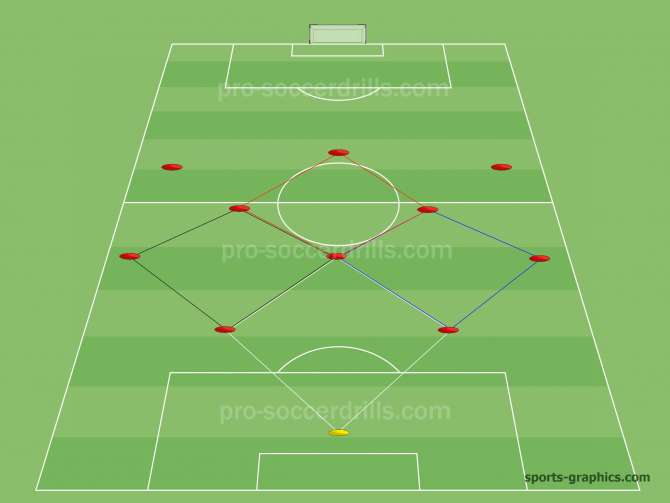
This is a 4-3-3 formation and there are only four diamond shapes highlighted but more can appear during the game as it is flowing. It can be seen that not every player will be able to score a goal after they successfully played the diamond shape so this is why we call the main attacker a “target man”.
There are other small-sided games to improve finding the target man, like in this drill: Possession and Speed of Play - Supporting Movements - Awareness
Roles of the diamond game also appear as there is always a player on the ball (pressure player), a cover player, a wide player (who gives width to the playing area) and a target man. These roles are constantly changing but a 4v4 game is great for teaching this method.
There is also a disadvantage of this formation as it is harder for the players to leave their positions and make interchanging movements because they need to destruct and then construct the diamond shape to be successful. This is always hard for kids to see this in-game.
The 2-2 (Square) formation
This formation is also a very common 4v4 formation to play with. The square, as a shape can also be found in the 11-a-side and it has horizontal and vertical sides. In the world of football most of the teams play horizontal passes to become able to play vertically. As there are two passes in the square that can be played vertically, this formation has the most vertical passing lanes according to the original positions on the pitch.
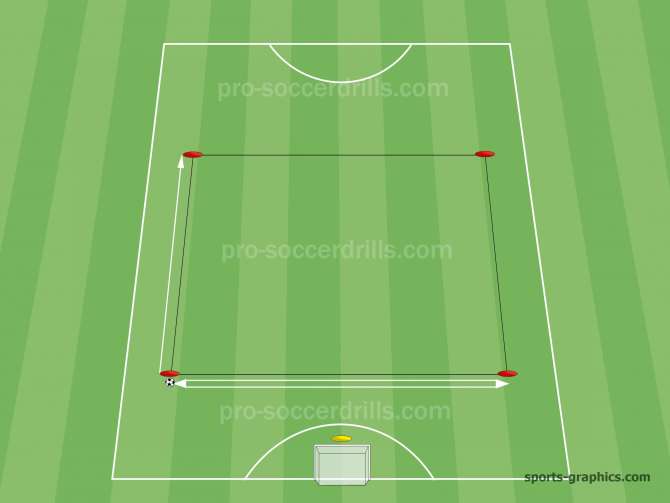
In our example, we used the 4-3-3 formation again highlighting a square (rectangle) shape.
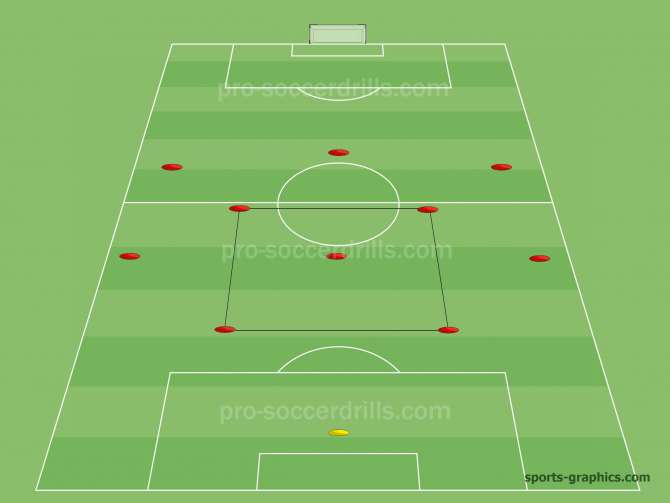
We can see that the defensive midfielder is missing from the players highlighted, although he is there in a 11 against 11 soccer game. In the 4v4 small-sided game, there will be empty space there that must be occupied by a player of the team in possession. Therefore the square shape is great for teaching and practising the vertical 2v1 situations. 2v1 is meant with a passive defender behind the target player.
So, space is left in the middle intentionally, but there is a huge need for that space in attack. Using this formation kids can be taught to run into empty spaces with or without the ball and if she/he didn’t receive the ball in time, go back to the position or find another one and leave the central area empty. This is a great shape to teach the kids how to make interchanging movements and how to help their teammates.
There is another advantage of this shape and that is teaching the build-up play with positions players can stick to.
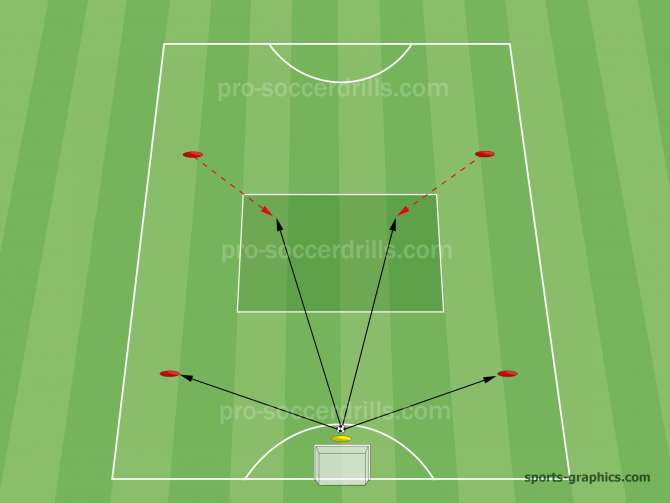
There is an empty space in the central area so there is no player standing there with a man on. That is an area that should be filled by a target man. The two defenders separate and create space in the middle and one of the two attacking players try to lose his/her marker and step back for the ball whether it’s needed. The goalie will have short and long passing options either.
Other, not so common 4v4 formations
The 2-1-1 formation
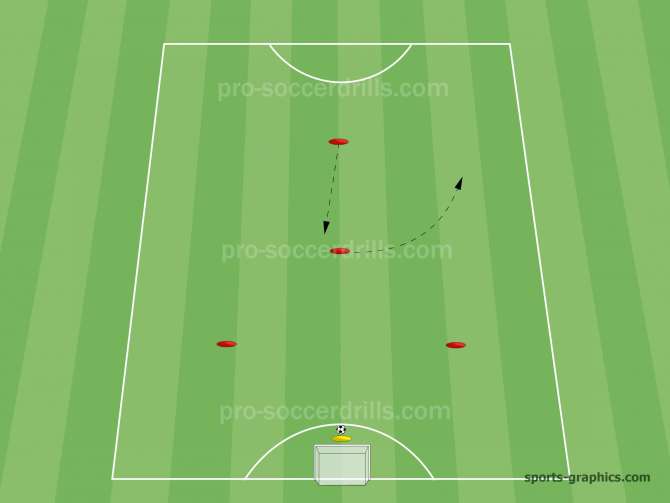
The 2-1-1 formation is a little bit difficult to play because there will be a triangle at the back and a lone target man away who needs to be played. As we give the instruction to the kids that there will be a 2-1-1 formation on the pitch, the kids are going to take their positions instantly and might not be able to leave it easily. Therefore the 2-1-1 should be played very intelligently and the player in the middle should be the most clever and intelligent player in the team who sees through the moments of the game and knows when to leave his/her space. After he/she lefts it, that will not cause a problem for another player to step in because kids know the “system” of play.
Continuous rotation can be practised through passing drills like this: Creating Triangles with Continuous Rotation 2
The 3-1, 1-3, 4-0 formations
The 3-1 formation also can be seen in a 11 vs 11 soccer game. Note that this is just the starting position of the players and many tactical variations can be taught after. The 3 players at the back should be encouraged to play a horizontal pass and then make a deep run into space. Then a diamond or a square formation will be seen on the pitch and the target man in the front should be aware and fill the back positions.
The 1-3 formation is pretty similar but attacking players should be stepping back constantly into space for the ball. So, again, many previously practised variations can be applied here.
There is a 4-0 and a 0-4 formation used in the world of futsal (very rare in kids’ soccer game) but organised, pre-practised variation movements start from these formations. Not so recommended for kids because they might not be able to interpret the game as coaches do.
Summary
4v4 football play is a great small-sided game to play as it develops the players’ brain, technique, skills and tactical understanding of soccer. Fewer players result in more touches and this SSG has a direction to attack and defend. Highly recommended game for any ages just for fun or to make the players gain more experience and force them to play faster and more cleverly.
Free Trial
GET YOUR FREE 14 - DAYS TRIAL NOW! INCLUDING:




